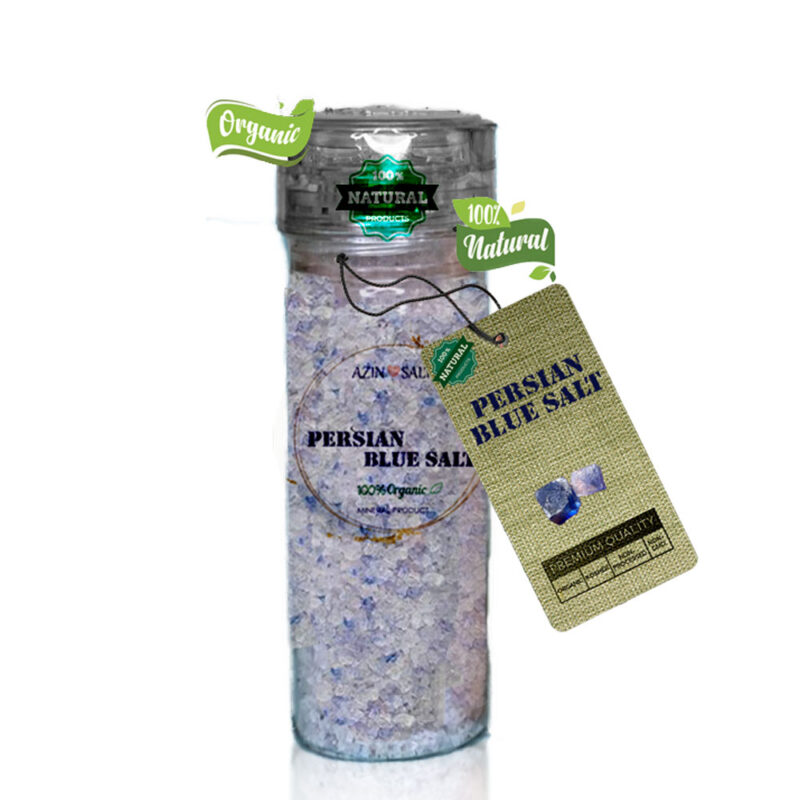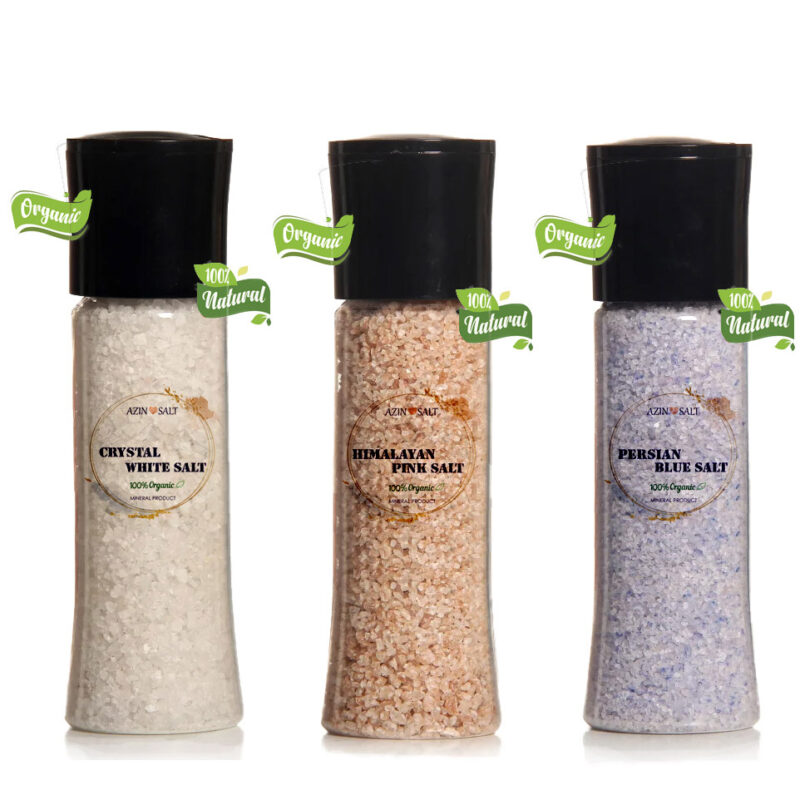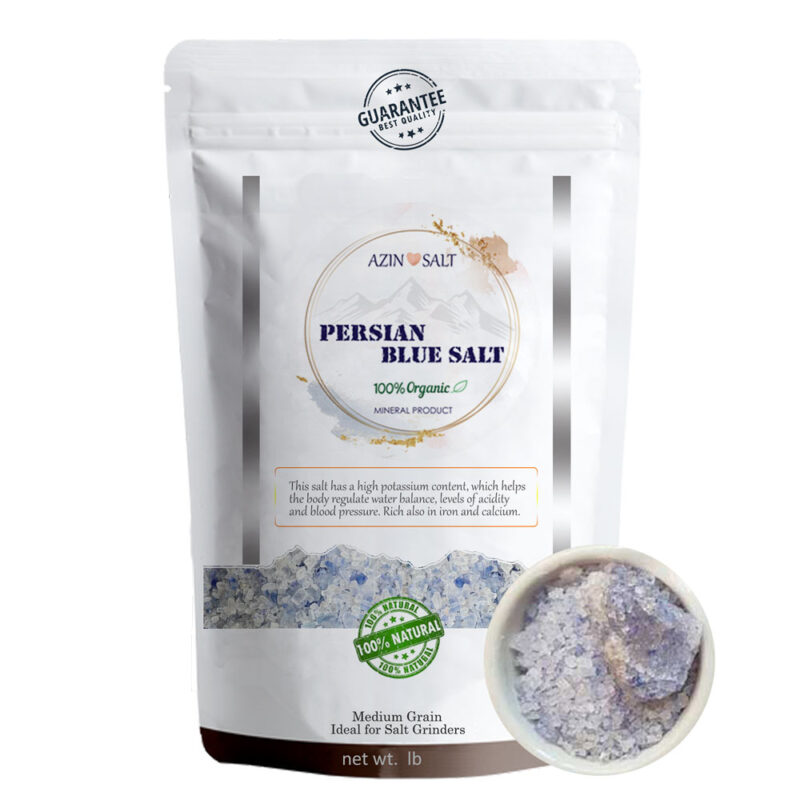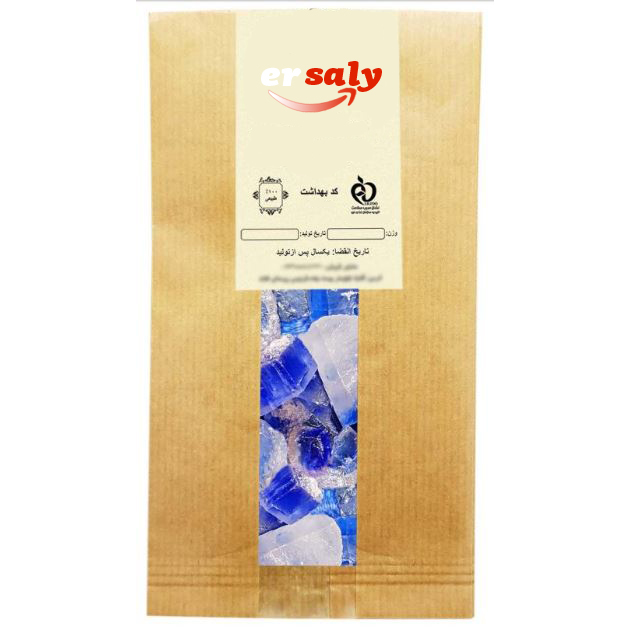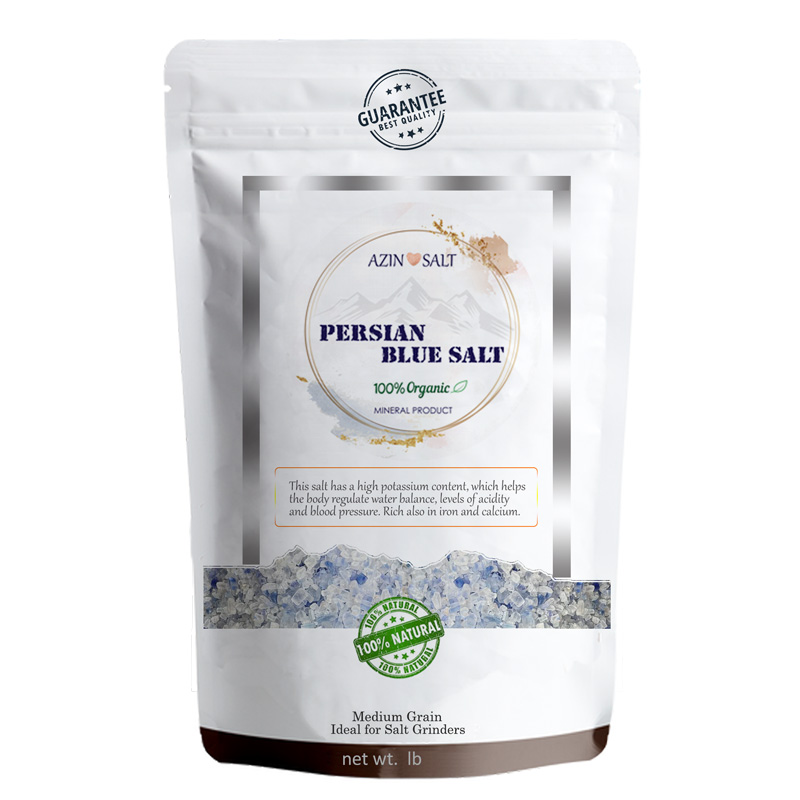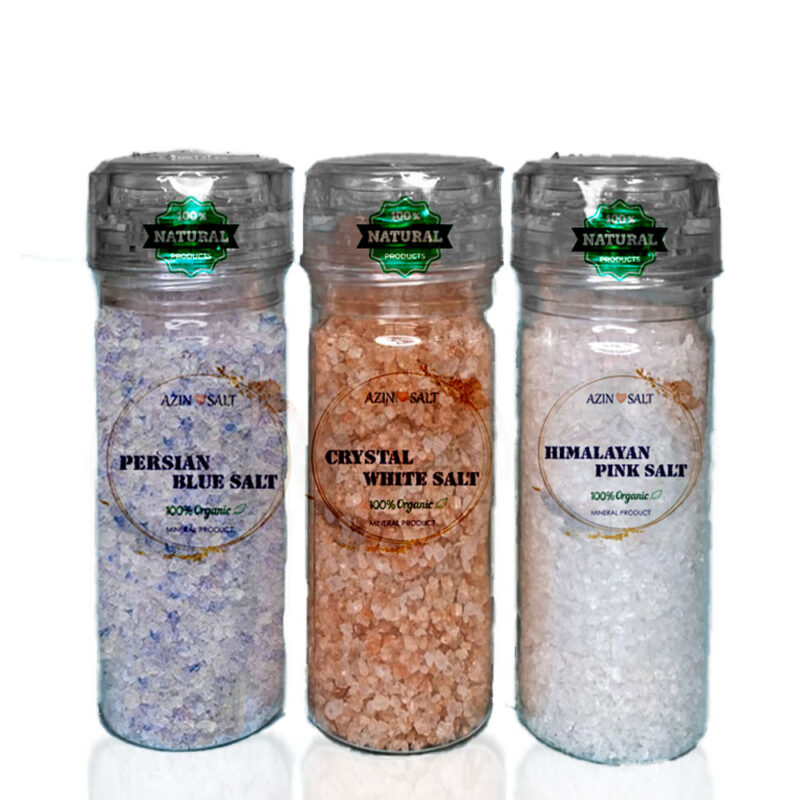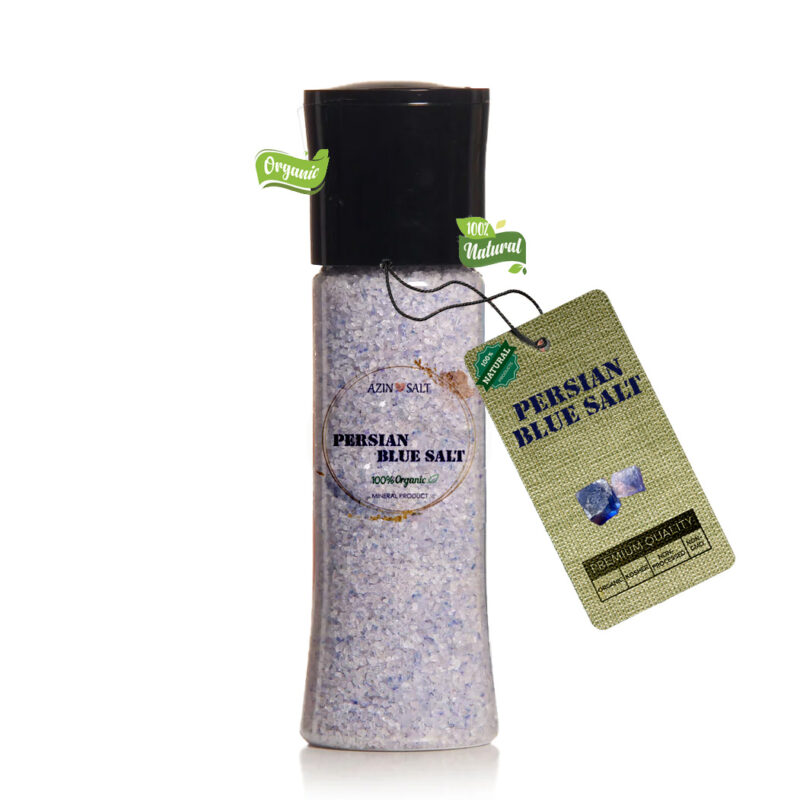Persian blue salt is a rare and exotic salt that comes from the mountains of Ergourz in Northern Iran. It is also called “fossil salt” because it was formed millions of years ago and has been kept underground ever since. The salt crystals have a special property that makes them reflect light strangely, creating a beautiful blue color that is an optical illusion like glaciers. Persian blue salt has a lot of minerals, such as potassium, calcium, and magnesium, which give it a different flavor and texture. It is often used as a finishing salt to make dishes such as foie gras and truffle more colorful and tasty.
Celtic sea salt, on the other hand, is collected from the coastal areas of Brittany, France. It is a natural, unrefined salt that is hand-picked using old-fashioned methods. Celtic sea salt has many trace minerals such as iron, zinc, and magnesium, which give it a different flavor and texture. It is often used in cooking and baking to make dishes such as roasted vegetables and baked goods more flavorful.
Both Persian blue salt and Celtic sea salt are unique and flavorful salts that can add a touch of sophistication to any dish. While Persian blue salt is best used as a finishing salt, Celtic sea salt is versatile and can be used in a variety of dishes. Ultimately, the choice between the two depends on personal preference and the specific dish being prepared.
Which salt is healthier: Persian blue salt or Celtic sea salt?
Both Persian blue salt and Celtic sea salt are natural and healthy alternatives to table salt, as they contain essential minerals and nutrients that benefit our body and mind. However, they also have some differences in their origin, color, flavor, and benefits.
Persian blue salt
Persian blue salt is harvested from ancient salt deposits in the central desert region of Iran using traditional and sustainable methods. The salt is hand-scooped from the salt mines and then sun-dried, preserving its natural mineral content and quality. Persian blue salt is not refined or processed, making it a pure and natural product that enhances the flavor of any dish.
Some of the health benefits of Persian blue salt are:
- Lower sodium intake: Persian blue salt is naturally lower in sodium than other types of salt, which means that you can enjoy its delicious flavor without the worry of excessive sodium intake.
- Supports hydration: The minerals in Persian blue salt, including magnesium and potassium, help to regulate fluid balance and support hydration.
- Boosts energy: The magnesium in Persian blue salt is involved in hundreds of biochemical reactions in the body, including energy creation, protein formation, and muscle movement. Magnesium also helps to reduce fatigue, stress, and anxiety.
- Improves digestion: The calcium in Persian blue salt aids digestion by stimulating the production of saliva and gastric juices. Calcium also helps to prevent constipation and acid reflux.
Celtic sea salt
Some of the health benefits of Celtic sea salt are:
- Heart health: Contrary to common misconceptions about salt and heart health, the minerals in Celtic sea salt can help regulate blood pressure and support cardiovascular health. Potassium, in particular, plays a vital role in regulating blood pressure and reducing the risk of hypertension.
- Skin health: Celtic sea salt can be used as an exfoliating agent to remove dead skin cells and unclog pores. It can also hydrate and heal the skin, as it contains anti-inflammatory and anti-microbial properties.
- Detoxification: Celtic sea salt can be used to make salt water flushes, which are a natural way to detoxify and cleanse the colon. Saltwater flushes can help to remove toxins, parasites, and waste from the digestive system and improve bowel movements.
What is Persian blue salt?
Persian blue salt is harvested from ancient salt deposits in the central desert region of Iran using traditional and sustainable methods. The salt is hand-scooped from the salt mines and then sun-dried, preserving its natural mineral content and quality. Persian blue salt is not refined or processed, making it a pure and natural product that enhances the flavor of any dish.
Persian blue salt can be used as a finishing salt, adding a touch of elegance and complexity to your meals. It can also be used to season meats, fish, vegetables, salads, soups, and desserts. Persian blue salt pairs well with citrus, herbs, spices, chocolate, and cheese. It is also a great ingredient for making margaritas, as it can coat the glass rim with its beautiful blue crystals.
What is Celtic sea salt?
The region’s clay gives Celtic sea salt a light grey color and a moist texture. It has a gentle and harmonious flavor that brings out the best in fruits and vegetables and boosts the body’s health. Celtic sea salt contains abundant alkalizing minerals, such as potassium, magnesium, iron, and calcium, which support hydration, energy, immunity, and digestion.
You can use Celtic sea salt as a table salt or a cooking salt to add a subtle and savory taste to your dishes. You can also use it to make salt water flushes, a natural way to detoxify and cleanse the colon. Celtic sea salt is also good for skincare, as it can exfoliate, hydrate, and heal the skin.
Differences between Persian blue salt and Celtic sea salt
Persian blue salt and Celtic sea salt have many differences, such as their source, production, color, flavor, health benefits, and uses. You can pick the salt that matches your needs and preferences. You can also savor the flavor and health benefits of these amazing salts in your cooking and dining. But don’t forget to use them moderately, as too much salt can harm your health.
-
Origin and production
Persian blue salt and Celtic sea salt have different origins and production methods, which affect their quality and appearance.
Persian blue salt is harvested from ancient salt deposits in the central desert region of Iran using traditional and sustainable methods.
Celtic sea salt is an unrefined variety of sea salt that is harvested from the coastal regions of Brittany, France, and parts of the British Isles, where seawater is channeled into clay ponds or salt marshes.
-
Color and flavor
Persian blue salt and Celtic sea salt have different colors and flavors, which come from the minerals and clay found in their respective regions.
Persian blue salt has a striking blue color, which is due to the presence of trace minerals, such as magnesium, calcium, and potassium.
Celtic sea salt has a moist texture and a light grey hue, which comes from the clay found in the region. It has a mild and balanced flavor that enhances the natural profile of fruits and vegetables while strengthening the body.
-
Health benefits
Persian blue salt and Celtic sea salt have different health benefits, depending on the minerals they contain and the amount of sodium they have.
Persian blue salt is naturally lower in sodium than other types of salt, which means that you can enjoy its delicious flavor without the worry of excessive sodium intake. Persian blue salt also supports hydration, boosts energy, and improves digestion thanks to the minerals it contains, such as magnesium, potassium, and calcium.
Celtic sea salt can help regulate blood pressure and support cardiovascular health thanks to the potassium it contains, which plays a vital role in regulating blood pressure and reducing the risk of hypertension.
Which type of salt is best: Celtic sea salt or Persian blue salt?
Persian blue salt and Celtic sea salt have different advantages and drawbacks, depending on what you want and need from a salt. Persian blue salt is a great option for those who want a salt with a distinctive flavor and high mineral content. Celtic sea salt is a better choice for those who value refined taste and a varied mineral profile. Both salts have many benefits for your cooking and health, helping you to improve your dishes and your well being.
| Salt | Pros | Cons |
|---|---|---|
| Persian blue salt | High mineral content, anti-inflammatory, antioxidant | Strong flavor, some people may not like the taste |
| Celtic sea salt | Clean, salty flavor, a good source of minerals, refined | Less mineral content than Persian blue salt |
If you like a strong flavor, Persian blue salt may be a good choice for you. Celtic sea salt may be a better option if you prefer a more refined flavor.
Here are some additional things to consider when choosing between Persian blue salt and Celtic sea salt:
- Flavor profile: If you are cooking a dish with a delicate flavor, you may want to choose a salt with a milder flavor, such as Celtic sea salt.
- Mineral content: If you are looking for salt with a high mineral content, Persian blue salt is a good option.
- Availability: Persian blue salt and Celtic sea salt are both available from some grocery stores and online retailers.
What is the taste difference between Persian blue salt and Celtic sea salt?
Persian blue salt and Celtic sea salt are both natural salts with unique properties and flavors. The taste difference between the two is due to their different mineral compositions.
Persian blue salt is known for its slightly sweet and metallic flavor. This is because it contains high levels of trace minerals, such as vanadium and copper. These minerals give Persian blue salt its unique taste and aroma.
Celtic sea salt has a cleaner, saltier flavor. It is also said to have a slightly briny taste. This is because Celtic sea salt is less processed than Persian blue salt. As a result, it retains more of its natural flavor.
Here is a table summarizing the taste difference between Persian blue salt and Celtic sea salt:
Which salt is more expensive: Persian blue salt or Celtic sea salt?
Persian blue salt and Celtic sea salt are both considered premium salts, but Persian blue salt is typically more expensive. This is due to several factors, including its higher mineral content, limited supply, and unique coloring.
Persian blue salt is harvested from a specific region in Iran called Zanjan, where the salt crystals are naturally tinted pink due to the presence of trace minerals like vanadium and copper. This unique color and high mineral content make it a more sought-after salt, driving up its price.
Celtic sea salt, on the other hand, is derived from ancient seawater deposits in the Brittany region of France. While it also boasts a rich mineral profile, it is more widely available and processed less extensively, which contributes to its lower cost.
Here’s a table comparing the average prices of Persian blue salt and Celtic sea salt:
| Salt | Average Price |
|---|---|
| Persian blue salt | $20-$40 per pound |
| Celtic sea salt | $10-$20 per pound |
in general, Persian blue salt is expected to be more expensive due to its limited availability and unique characteristics.
Where can I buy Celtic sea salt and Persian blue salt?
One of the best online stores to buy Persian blue salt and Celtic sea salt is Ersaly. Ersaly is a trusted and reliable online store that offers a wide range of high-quality salts from around the world, including Persian blue salt and Celtic sea salt.
Ersaly also provides fast and secure delivery, competitive prices, and excellent customer service. You can browse their website and find the salt that suits your needs and preferences, and enjoy the taste and health benefits of these amazing salts in your cooking and dining.




